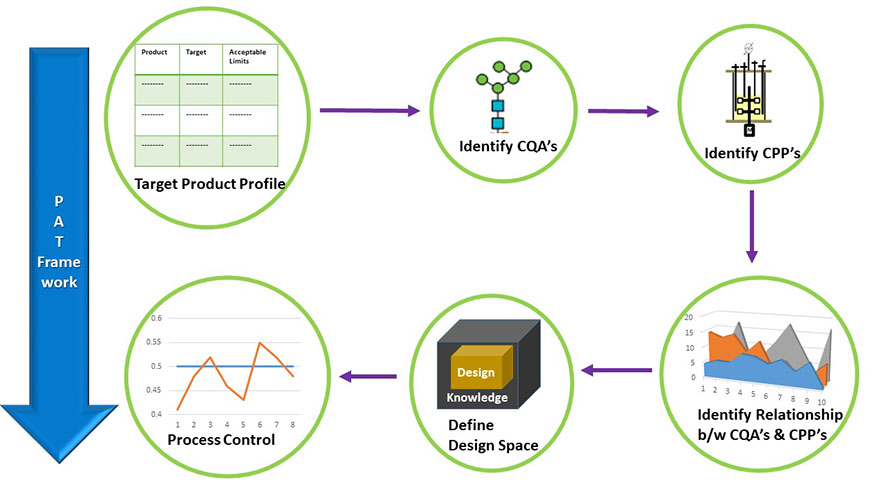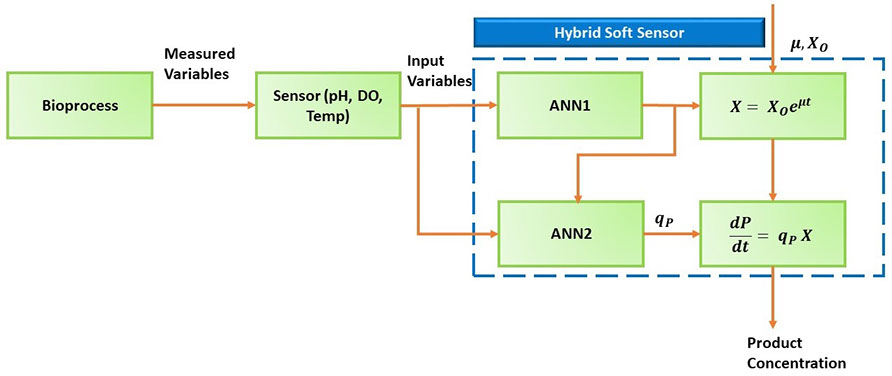
Bio Process Analytical Technology (BIOPAT) Laboratory
Phone: +91-361-2582226 (O)
Email : senthilkumar[AT]iitg.ac.in
Research Area
Real-time Monitoring and Control
A bioprocess involved in the cultivation of microorganisms undergoes a complex combination of various chemical, physical and biological changes. As a result, bioprocesses are non-linear and dynamic in nature. In order to produce a quality product at desired quantity it is essential for a bioprocess to operate at optimal environment. Process Analytical Technology (PAT) proposes the conceptual idea of ‘Quality by design’ (QbD), emphasizing on the product quality in real-time at the earliest stage of production rather than quality assessment of the finished product. To implement QbD for a bioprocess it is important to understand about Critical Process Parameters (CPP’s) that are governing Critical Quality Attributes (CQA’s) of a product. Crucial part in controlling CPP’s is obtaining timely measurements of bioprocess state variables. Direct information about these variables is seldom available. To overcome this bottleneck PAT based sensors and soft sensors are vital in bioprocess control. Our team successfully developed/deployed PAT based tools and soft sensors using mechanistic modelling and hybrid modelling for real-time monitoring and control of bioprocess.

Implementation of PAT framework in real-time monitoring and control of bioprocess systems
PAT tool developed indigenously at BioPAT lab
Heat Compensation Calorimeter
Nearly all microbial systems dissipate Gibb’s free energy because of the thermodynamic spontaneity from the combustion enthalpy of the substrate. Biocalorimeter deciphers biological heat rate, as a result of metabolic interconversions due to the utilization of substrate towards competitive pathways. Heat rate evolved out of the calorimetry offers an advantage to elucidate the viable cell concentration and other kinetic parameters of growth associated. Our research group developed a novel Heat compensation fermentation calorimeter accompanied by two independent PID controls for temperature control during the fermentation process. First, PID control is engaged with the compensation heater in actuating the heater output. Second PID control acts on jacket temperature and two control loops combined to maintain the reactor temperature at the desired setpoint. Successful monitoring of various systems viz., bacteria (Streptococcus zooepidemicus) and yeast (Pichia pastoris) has been accomplished. The calorimetric signals fingerprinted the changes in cellular metabolism and process behaviour with viable precision. The developed high-sensitive calorimeter serves as a reliable PAT tool to design a soft sensor to estimate CPP’s like specific growth rate. By employing process control strategies and using information from developed soft sensors, we regulated the substrate feed rate that aided organism growth at the desired specific parameter setpoint value.


Principle of heat compensation calorimeter operation
Heat Compensation calorimeter as PAT tool for monitoring of huIFNα2B production using P. pastoris. Real-time heat rate signal (Black continuous) corroborating with real-time capacitance signal (Red continuous) and offline DCW (Blue and Black continuous)
(Reference: Srikanth et al, 2020, Biotechnology Progress)
PAT tools used at BioPAT lab
Dielectric Spectroscopy
Dielectric spectroscopy is a process analytical tool employed to measure viable cell concentration in real-time for a fermentation process. It operates on the principle of polarization of cell membranes. Each viable cell carries a charge around the cell membrane and this charge can be measured in terms of either capacitance or conductance by the probe. As dead cells do not have an intact membrane, they do not act as capacitors. Thus, DS helps in detecting only viable cell concentration. By applying suitable mechanistic models, specific growth of a process can be inferred through a soft sensor. Our group has developed a soft sensor to obtain real-time values of specific growth rate for Pichia pastoris fermentation process. A simple PID based control strategy was implemented to control specific growth rate in real-time in the production of human interferon α2b. In another study, an optimal substrate feeding profile was achieved by formulating multi-objective optimization (MOO) problem for E. coli system expressing a recombinant protein. Real-time inputs for mechanistic model deployed to MOO problem were attained through dielectric spectroscopy.


Principle of Dielectric Spectroscopic real-time monitoring of viable cell concentration
Dynamic profile for dielectric spectroscopy based monitoring of huIFN α2B production by Pichia pastoris
Exhaust Gas Analyser
Gaseous phase O2 and CO2 concentrations from the exit stream of fermenters are measured real-time in the form of mole fraction using lab scale exhaust gas analyser. Changes in the concentrations of these exhaust gases could directly fingerprint the on-going metabolic activities and act as auxiliary PAT tool for real-time monitoring and control of bioprocess.

Real-time oxygen uptake rate (OUR) from exhaust gas analyser (Green continuous) and CER (Blue continuous) corroborating with real-time capacitance signal (Red continuous) for huIFNα2B production by Pichia pastoris (Reference: Srikanth et al, 2020, Biotechnology Progress)
Optical Density (OD) Sensor
Near-infra red (NIR) based OD probe can measure the growth of microbial cultures as a function of NIR absorption. NIR light has the advantage of being less absorbed by soluble media components. The attenuation of the light intensity caused by absorption by dissolved substances and undissolved material is detected by a hermetically sealed photodiode. As a result, online measurement without sampling or dilution is possible over a vast and linear OD range. A soft sensor can be designed for real-time monitoring and control of bioprocesses by developing correlation with online measured OD value and offline values. In addition, it will be used a complementary PAT tool to validate the performances of other sensors.

Application of Optical Density (OD) sensor for real-time bioprocess monitoring
Advanced process control
Application of optimization and advanced process control strategies are beneficial in reducing the process variations which thereby aids in maintaining the quality of the desired product. Since product quality is one of the critical quality attribute (CQA) in any bioprocess, application of suitable control schemes to maintain the same is one of the aspects of Process Analytical Technology (PAT) implementation. Dynamic and highly nonlinear nature of the bioprocesses with changing yield coefficients throughout the process emphasises the application of a supervised control strategy in order to handle the dynamic changes. Advanced process control strategy such as Model Predictive Control (MPC) can handle a multi-input multi-output system (MIMO) and the interactions that might happen between inputs and outputs. Additionally, the predictive nature of advanced process control is beneficial to take real-time actions and is therefore relevant to reduce the batch-to-batch variations of the process. Definition of the control objectives can vary depending upon the final goals to be achieved. Some of the possible control objectives could be maximizing process yield, maximizing product-concentration, minimizing by-product formation, etc. On-line optimization and advanced process control strategies are implemented as a supervisory layer which provides the set-points for the regulatory control (Proportional-Integral-Derivative (PID)) layer which further keeps the underlying process in control by providing suitable manipulating variables (MVs).


Overview of implementation of advanced process control strategies in bioprocesses
Methodology for implementing Multi-Objective optimization (MOO) for achieving optimal substrate feeding profile (Reference: Swaminathan et al., 2020, I&ECR)
Measurement, Monitoring, modelling and control are four significant pillars of bioprocesses which operates hand in hand in order to achieve enhanced product quality. Development of mathematical models that represent the underlying bioprocess is a significant initial step towards implementation of any optimization or process control strategy. Models can relate the measured critical process parameters (CPPs) to the desired critical quality attributes (CQAs) and some of the components of development of mathematical model includes sensitivity analysis and parameter estimation. The real-time monitoring data acquired from the process can be used to develop and validate the mechanistic model which can further be used to implement appropriate optimization objectives. The integration of the prediction capability of a mathematical model with the real-time Dielectric spectroscopy measurements for implementation of an optimization strategy would be beneficial in achieving optimal protein production. Various optimization objectives including biomass maximization and by-product minimization can be implemented wherein different manipulated variables (MVs) like the substrate feed rate and air feed rate can be chosen accordingly.
Soft Sensor
Soft sensor or software sensor has been in place for the case of industrial process monitoring since last 1-2 decades. The central idea behind a soft sensor is to use easily accessible real-time data for the estimation of state variables that are otherwise either difficult to measure or only measured at low frequency. A hybrid model is a result of integrating mechanistic and data driven model. Rate parameters are difficult to estimate in real-time due to unavailability of hard sensor, data driven model is used to predict state variable and further it will be used as input for mechanistic model. This approach requires minimal data knowledge and data which is an advantage as compared to big data driven methods and processes where mechanistic modelling is quite complex. Our group developed a hybrid based soft sensor by combining data driven model and mechanistic model for prediction of hyaluronic acid concentration.

Application of hybrid soft sensor for bioprocess monitoring
Copyright @ BioPAT LAB, IIT Guwahati.